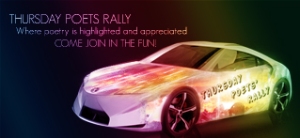Monthly Archives: April 2011
Staring at the face of Evil
Staring at the face of Evil
Today I took Hector to the hospital to visit the sick people. On my way out, an EEG tech stopped me to ask about Hector. We were talking in the main hall when a slimy, sleezy man walked by. He was about 6’3″, very thin, really redneck looking, usual redneck uniform: jeans and a t-shirt, with a baseball cap. He had white ear buds in his ears. Hector looked at the man, hunched back into defensive position, put his tail between his legs and growled a basso grumble.
I stared at the man, thinking, “this must be an awful person.”
He stared right back at me, looked me straight in the eyes and said, “He sure knows a bad person when he sees one.” He turned and headed toward the elevators.
The tech and I looked at each other, mouths agape. I moved over to the tech and whispered, “I was just thinking that he must be a very bad person.”
The tech answered, “What terrible things did he do that he knows he’s such a bad person?”
You can’t imagine the chills that went up my spine, raised the hairs on my arms and my neck, and just spooked me beyond belief.
After that, Hector kept his tail between his legs for awhile. The next man who came over to him, with a long ZZ-Top type of beard also scared him. However, when I looked at that man’s beady eyes, he did not seem the epitome of evil.
Sonnet XXIV
Sonnet XXIV
Light from the moon hits Earth’s dense atmosphere
in the low opaque areas that are wet.
Then the apparent lunar photosphere
emits green light as Luna starts to set.
The grey moon seems orange in the dark sky,
then a rare flash appears out of nowhere,
as a giant prism paints verdant die
and a blazing mirage seems to hang there.
Lunar soil releases ionic
streams as it is hit by the solar winds.
Then it wears a crown that seems demonic
’til the moon in the sky sets and rescinds.
The air helps bend light into frequencies
like weaving bright threads of embroideries.
**********************
I just found out about this phenomenon today on the New Scientist page . Then I wrote this sonnet.
Digg Newsrooms also has some interesting comments.
Sonnet XXVIII
Sonnet XXVIII
A giant wedge, forced up on a summit.
The melted rock on crumbled mountain tops.
The nuggets of silvery snow sunlit
on the landscape. The inverted planet drops
off in a land of ribcage hill torrents.
Expiring geophysical breaths
dissipate in thin air. An act warrants
a vaporized battle to ensue. Deaths
of sediments squeeze onto plates. Trivia
tells that magnetic deposits today,
are charged by Earth’s fields. Here, where India
and Asia crashed, crust was carried away.
Since much is veiled, this view only reports
mountains with crowns of luminescent quartz.
*******************
This shot was posted by @Astro_Ron on Earthday of 2011. Ron Garan is a New Yorker, like me. He flew F-16’s as a test pilot, in USAF, around the time I was a test engineer for at the 416th at Edwards, yet I never met him. : (
You can read more about him http://www.jsc.nasa.gov/Bios/htmlbios/garan-rj.html
Posted on:
The Earth
The Earth As Seen From Apollo 17
Clouds weave quick patterns like silken white lace;
No borders are drawn on lands seen from space.
Such beautiful seas, and bounteous lands;
The oceans, the rivers, the snows and sands;
I have searched the universe high and low
Yet cannot detect such a well made show.
It’s hard to define Earth’s magnificent life:
The glory, happiness, sorrow and strife.
It’s pitify man does not fully know
The glory of life: to produce and grow.
Earth’s life’s a marvel, I clearly can see.
I daren’t imagine how no life would be.
Out in the heavens I see my Earth fly
Like a blue-snowy crystal, on black-velvet sky.
********************************
This is the first Sonnet I ever wrote, back in 1972. It is not even a Shakespearean Sonnet. I wrote it while Apollo 17 was returning from the moon to Earth. Jack Schmidt said that he had wished he were a poet so he could write about how beautiful the Earth is. I wrote this sonnet and sent it to him. He must have really liked it because he sent me back a letter thanking me for the poem. Also, 20 years later, I wrote to him again and reminded him that I was the one who sent that poem, and he seemed to remember the poem.
Most of you know the picture above. But some probably don’t know that this is the first full picture of the Earth taken by man. I was lucky enough to meet Gene Cernan in Seattle, back in 2000. I asked him who took the picture, and he said he didn’t know. He said they had one camera, and they all took pictures whenever they saw fit. No one knows exactly who snapped that picture. That’s why, whenever you see the picture, it is credited to the entire crew of Apollo 17.
Here’s a great picture of the crew . The magnificent Saturn V rocket is in the background, and the Lunar Rover is in the foreground. Amazing engineering for the sixties. It’s the technology that got us where we are today.
Posted on:
Poetry Picnic Week 14: What I’m Thankful for in My Life
Also published for:
poets-rally-week-60
Sonnet XXVII

Baby Stars Blasting Out Jets of Matter
Sonnet XXVII
In the minute birthplace of many stars,
A dazzlingly glowing blob of gas
Expels gusts of matter, blasts out scars
And hides luminaries in the dense mass.
Arc-shaped features are found within this scene;
bow-shocks rejuvenate faster than sound
as bursts of short vertical arcs careen
turbulently. Blue and red flares rebound
into violent filaments of pink.
Comma shaped jets curve into long streamers,
swimming in a mist of hydrogen ink.
Only the astronomers and dreamers
see the havoc caused on this exalted scale
where stars are born behind a gauze-like veil.
**********************
I saw this picture in the blog of @badastronomer , AKA Phil Plait, who writes for Discover Magazine. I knew I had to write a poem about this. This was written in 2011. It’s amazing that we can see stars being born, and understand that this is what we are seeing.
Posted on:
Sonnet VII

The Black Eye galaxy is seen in this Hubble Space Telescope image released in 2004.
Sonnet VII
“The Dark Mass Theory”
Pluralities of worlds occasionally
Fly steadily through narrow slits of gas.
We scan endless skies periodically,
Yet still we can’t explain how missing mass
Is found. Deterministic randomness
Pervades the structure of the universe;
A slice of space is deem’d homogenous
In density; such logic is perverse.
Flung envelopes of stars become surreal
Compared to the time dilation of the Earth;
Galactic flight around a dark pinwheel
Is slowed by something pulling on its girth.
Though theories seem to change and oscillate,
Reality will always subjugate.
****************************
I wrote this in 1993. I found the concept of Dark Matter fascinating.
National Geographic can inform you further.
Posted on:
Thursday Poets’ Rally (November 3-November 9, 2011) Week 55
Sonnet IV
Sonnet IV
(The Jupiter Sonnet)
Dense bubbles in the sky are doughnut holes
Embedded in a crucial fluid jamm’d
Into a violet space; electron moles
Are gaseous atoms racing to get slamm’d
Above. Pure shades of higher thought foresee
Endless sweat on faces cast in plasters;
These glowing swirls of cumulus are three
Dimensional portraits of the masters.
Behind a blue wake trails a yellow ball
A sheet of light speeds through the atmosphere.
The clouds which tumble through the frightful squall
Are color tear drops melting from God’s ear.
Tornadoes overwhelm the Great Red Spot.
From here, that planet is a starry dot.
*********************
This is my most famous sonnet. Written in 1993, it is on display at Kennedy Space Center, in the art gallery, located in the IMAX building. In the picture above, my Aunt and Uncle (mother’s sister) are in front of the painting by which my sonnet is displayed. Notice the little plaque next to my aunt. That’s it.
Posted on:
The Poetry Pantry Is Now Open! – #73
This website has an interesting animation of the storms on Jupiter. It’s also a good example of classical fluid dynamics.
http://www.haydenplanetarium.org/resources/ava/solarsystem/P0413jupispot
Sonnet XIII

“Dragon Storm” Saturn
Sonnet XIII
(The Saturn Sonnet)
Saturnian systems tend to evolve
rich patterns of textured variations
as landscapes scatter, format and revolve
broad superimposed amalgamations.
Dynamic harsh winds strike a fresh mountain
of crystal ammonia freshly punched through
the faint bleached clouds pouring from a fountain
that eats the left edge of a storm’s white hue.
Equatorial burps of gas protect
the arrowhead wedge that out-runs the wind
and shows off the planet like an insect
whose stylized wings can flex and rescind.
Rings are not the only object to see.
The surface paints up a full gallery.
*************************
Cassini showed us that Saturn has more to it than just rings. I wrote this one in 1995, which means I hadn’t even decided to go back to school to study engineering yet.
You can read more about the picture above on:
http://www.allamericanpatriots.com/48746240_nasa-extends-cassinis-grand-tour-saturn
Posted on:
Sonnet XXI
The Age of The Exoplanet
Sonnet XXI
Brilliant chromatic belts rotate about
A collection of gas which just beguiles
As it forms in Taurus. There is no doubt
between us are one million billion miles.
The first planetary discovery,
Aside from some proto-typical finds,
Has now been christened TMR-1C
By non-romantic, scientific minds.
This gravitational threat to fly by
Masses, may have rings orbit its big hips.
The giant babe of two bright stars might try
To catch comets on their cyclical trips.
If rocky moons are in its youthful skies,
Then some type of life may some day arise.
*****************
I wrote this in 1998, which means I was studying engineering at the time and still living in Seattle.
This is a great Hubble picture of a planet being formed. You can read more about it on:
http://news.discovery.com/space/phantom-planet-comes-back-from-oblivion.html
Posted on:
Sonnet XXVI
Sunset over Western South America
Sonnet XXVI
The light scatters in ways no one ever
conceived. The sun’s effects permanently
continue, and there’s no chance to sever
ourselves from power that radiantly
shines on horizon’s edge, for sunlight
is as diffuse as life on earth below.
In orbit, at a superlative height,
the landscape is of mountain and plateau.
Observe the graphic spectacle, more real
than anything a human can witness.
It’s a palace spinning like a Ferris-wheel,
from whence no one leaves, yet all must egress.
On the planet, darkness is divided
by rays of light the sun has provided.
*******************
NASA posted the picture above on the “Earth Observatory/Image of the Day Page.”
@NotAJoe on twitter tweeted the link. After viewing the image, I wrote the following haiku:
on the edge of space
sunlight lights the horizon
diffuse, like earthllife
Then I decided to write the sonnet I posted above. Check out the NASA link if you want to know more about it. The link discusses “the terminator.” Terminator is the changeover between day and night, as seen by someone in orbit.
Posted on:

The Poetry Pantry Is Now Open! – #77













 Verification wastes my time, and often doesn't work. I am going to stop commenting on pages that require verification one of these days.
Verification wastes my time, and often doesn't work. I am going to stop commenting on pages that require verification one of these days.